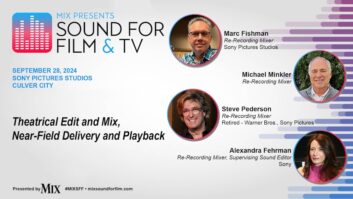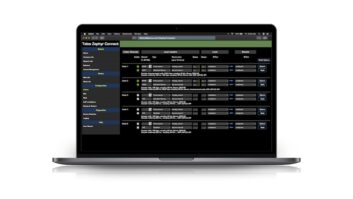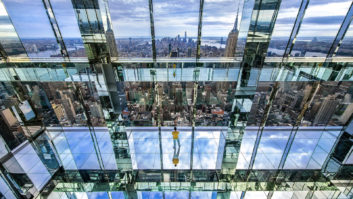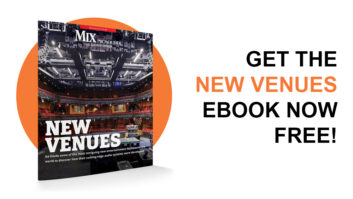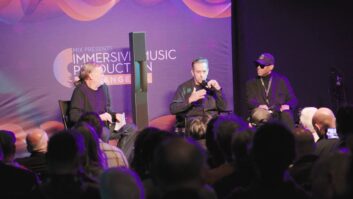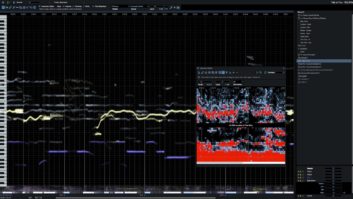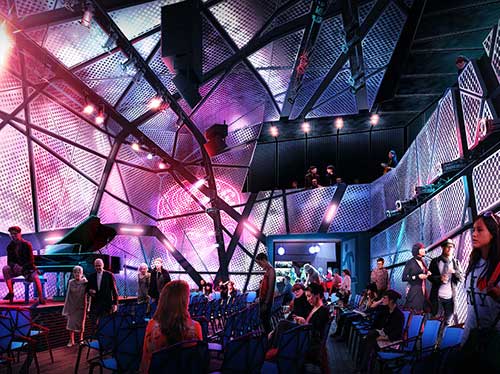
On October 1, Brooklyn’s Williamsburg neighborhood will see the opening of National Sawdust at 80 North 6th Street, on the corner of Wythe Avenue. The $16 million, 13,000-square-foot non-profit performance and recording venue is situated inside the 100-year-old brick shell of a former sawdust factory that is three doors away from the Music Hall of Williamsburg. National Sawdust features a main concert hall with a balcony, a restaurant and bar, and a basement that houses a studio for recording, mixing and mastering. The main space can accommodate up to a 70-piece orchestra, and up to 170-seated guests or 350 standing guests.
The venue is the brainchild of Kevin Dolan, a tax attorney and amateur musician and composer who purchased the industrial property in 2009. Dolan’s mission is to support emerging musical artists in varied genres through programming and by providing a facility for rehearsal and recording.
A collaborative spirit was present from the beginning of the project, as Dolan assembled a team comprising design firm Bureau V, SLAB Architecture, acoustic design firm Arup and veteran audio engineer Sascha von Oertzen, the Technical Director of National Sawdust, to help him realize his vision. The team worked from the inside outward to adapt the long-dormant structure for use as a music hub.
“A room needs to be a certain size to work for a piano,” says Bureau V founding principal, Peter Zuspan. “So we started to work with Arup from the interior of the space. I think we were basing it on a [European] chamber hall from the 18th century. I think the proportions are somewhat similar. We have a little bit of the curtain-like theatrical element. As you come in from the lobby to the performance space, there’s a 10-foot-by-10-foot acoustically rated door that rises up vertically into the ceiling to open up the house. And then it will seal you off for acoustic performances.”
Arup began its interior acoustical design by first addressing exterior concerns. “The first step was to measure the level of vibrations from the [L-line] subway,” says Raj Patel, Global Acoustics Leader for Arup. “A lot of [external] noise sources in combination dictated the fact that we had to have an isolated box-in-box construction for the performance space and all of the critical listening spaces. Everything that connects to those spaces is also isolated. The only non-isolated spaces are the changing rooms.”
With von Oertzen and City Winery’s chief production officer Ed Greer acting as advisors, Bureau V, Patel and Arup’s Matthew Mahon devised a system of variable acoustics, which Dolan wanted to be concealed. “Bureau V developed this interior skin that we call ‘the canopy’ for the performance hall,” Mahon says. Patel adds, “It touches the ground perimeter edge of the entire isolated floor plate. It’s a visually opaque, acoustically transparent shell.” According to Zuspan, “We had quite a few massive, acoustic-absorptive curtains. We worked with Arup on developing, and actually appropriating, metal and fabric composite panel-based skin.”
Von Oertzen oversees equipment selection. The main P.A. system is a d&b audiotechnik Qi Series with D6 amplifiers, Renkus Heinz surround sound and FX speakers, and Yamaha DME processing for a delay matrix. The balcony features a booth designed for both mixing live sound and for recording in isolation, thanks to a system of doors, hatches and operable partitions. At front-of-house is a DiGiCo SD8 console with a 24-channel frame and an additional MADI interface for recording and virtual sound check mixing, plus DiGiGrid interface and Bricasti M7 reverb. Mics include eight DPA models mounted in the ceiling above the stage via Servoreeler retraction systems, plus Neumann, Sennheiser, Royer Labs, Coles and AKG models.
“For now the focus is more on live recording,” von Oertzen notes. “We’re trying to maximize possibilities within the space, and that’s very special to me.
“The connectivity of the space is designed to be as flexible as possible,” von Oertzen says. “Most spaces adjacent to the main performance space, including the restaurant, have tie lines and connectivity to the backstage area and control spaces. We have a little backstage area that has the mic pre’s and the interfaces. It will have the DiGiCo SDRack setup, but it will also have other analog mic pre’s, Radial mic splitter and a Prism interface, and the [Merging Technologies] Horus mic pre and interfaces that can then either tap down to the production room in the basement, or to the control booth upstairs.”
The production room is floated and isolated, with an Argosy desk housing a Pyramix system, Avid Artist Mix control surface and racks for future outboard upgrades; a movable Pro Tools | HDX system with a MADI interface; PMC twotwo.5 surround system with Grace Design m906 reference control; and a Sony DRE77 Reverb, TC 6000 reverb, Prism compressor and Genelec 1031 speakers provided by producer/engineer Adam Abeshouse.
“For me it’s been an interesting challenge to combine the best of the two worlds of live sound and recording,” von Oertzen says. “I like the idea of helping this kind of musicianship that’s really tied to performing.”

